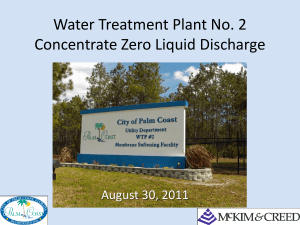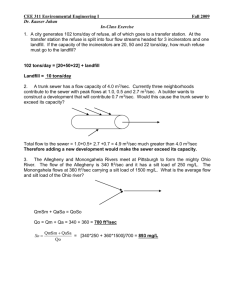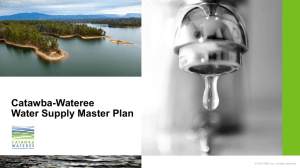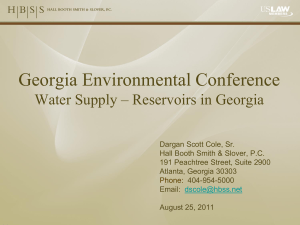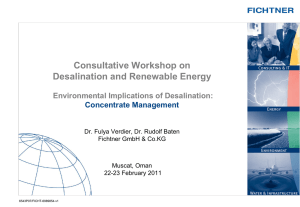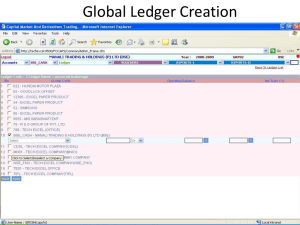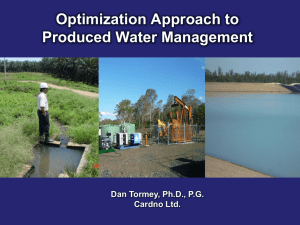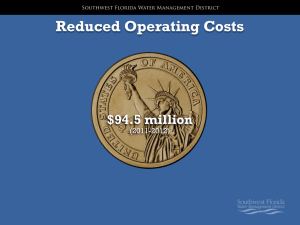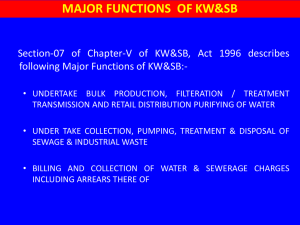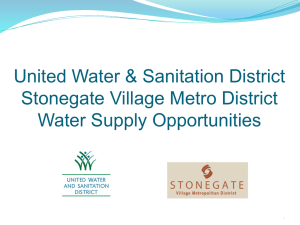New Technologies for the Water Treatment Toolbox - Multi
advertisement
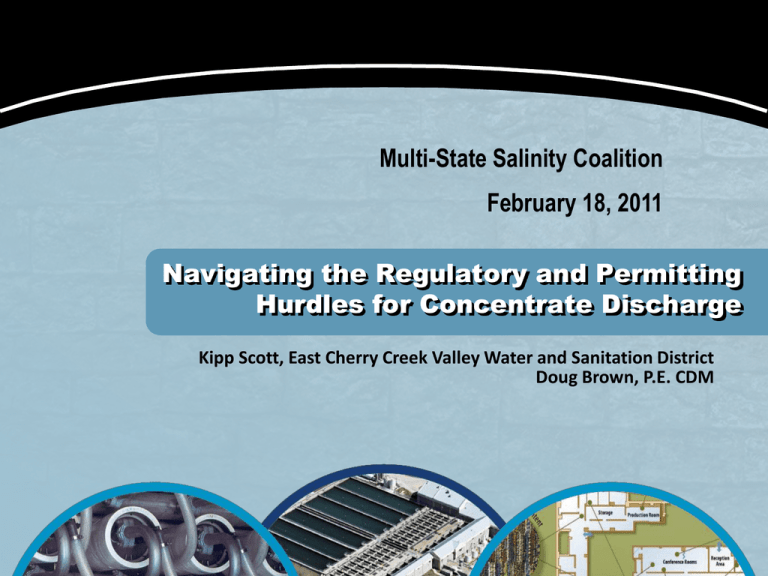
Multi-State Salinity Coalition February 18, 2011 Navigating the Regulatory and Permitting Hurdles for Concentrate Discharge Kipp Scott, East Cherry Creek Valley Water and Sanitation District Doug Brown, P.E. CDM Presentation Outline Background on ECCV Project Overview of Brackish Water Reverse Osmosis (RO) Treatment Factors Affecting Residuals Disposal for Inland Facilities Disposal Alternatives and Regulatory Issues Southeastern Denver Has Limited Surface Water Supplies and Relies on Imported Water or Deep Non-tributary Groundwater Existing ECCV Water Supply Is Being Depleted and Is Not Renewable ECCV initially relied on dozens of non-tributary groundwater for its water supply The Arapahoe and Laramie/Fox Hills aquifers have less than 300 mg/L TDS and 100 mg/L hardness 1 mile ECCV Is Diversifying and Conserving Its Water Supply Non-potable Irrigation with Reclaimed Water Denver Treated Water Block Water Rates Conservation Incentives Reduced Demand 30% from 1995 ECCV Water Well Production will Decrease 50% in 10 Years Requiring 377 New Wells The Northern Project Beebe Draw alluvial wells Phase I water rights – 70 Ranch Phase II water rights – Barr & Milton shares Phase I facilities Well field Pump Stations Waterline Renewable Groundwater from Northern Project Being Blended with Other District Supplies Water Treatment Planning Objectives Consistent quality product Free of objectionable taste and odors Water quality meets end user requirements Consistently meets drinking water standards Specific water quality targets Total Dissolved Solids < 300 mg/L Total Hardness < 100 mg/L Firm treatment and pumping capacity to meet peak demands Reliable service Reasonable operating costs Selection of Water Treatment Process High hardness and TDS required blending or reduction of these compounds Blending is not a long-term solution Lack of long-term blending sources Reverse Osmosis selected Most cost-effective for TDS Only effective process to consistently meet water quality goals Also eliminates almost all other potential contaminants from effluent dominated sources The challenge is the disposal of the concentrate stream (brine) from the treatment process ECCV Northern Water System 47 MGD Ultimate Capacity Overview of RO Process and Concentrate Disposal Typical low pressure RO operating at 85% recovery treating GW with 700 mg/L TDS & 300 mg/L hardness 6.7 MGD of permeate blended with 3.3 MGD of UV treated well water 1.2 MGD of concentrate with 5000 mg/L TDS RO Concentrate Disposal Options 1. Discharge to Sanitary Sewer System or POTW Discharge 2. Surface Water Discharge through NPDES permit a. b. navigable waters irrigation ditches 3. Deep Well Injection 4. Beneficial Uses 5. Zero Liquid Discharge Using: a. b. c. thermal/mechanical evaporation systems enhanced evaporation system passive evaporation basins 50 45 40 35 30 25 20 15 10 5 0 50 45 40 35 30 25 20 15 10 5 0 Mass of Salt Discharged is Constant 50 60 70 80 Recovery Percent 90 100 Concentrate Volume % RO Concentrate TDS ppt (assume 1000 mg/L raw water) Brine Concentration & Volume Vs. Recovery Potential Impacts of RO Concentrate on Wastewater Treatment Plant 1. Decreased hydraulic residence time and 2. 3. 4. 5. 6. potential impacts on effluent BOD and TSS Increase in effluent TDS Potential Increase in Elements such as Radionuclides, heavy metals, nitrates Potential Inhibitory Effect on Treatment Biology at High % of Concentrate Potential Impact on WET Tests Potential Impact on Equipment Corrosion Brackish RO Concentrate Typically Does Not Exhibit Acute or Chronic Toxicity Wastewater System Concentrate Management Options 1. Blend Concentrate with the Treatment Plant Effluent 2. Send Concentrate Through System During OffPeak Times 3. Pre-treat Concentrate for Specific Contaminants of Concern: Heavy Metals, Nitrates, Radionuclides 4. Develop a Salt Balance for the Basin to Demonstrate No Impact on Total Salt Discharge Adding a RO System to an Existing Water Supply Results in a Neutral Salt Balance River M Blend 40 tons/day 2.5 mgd Irrigation Return Flow POTW Salt 10-mgd Existing Brackish Wells @ 1,000 mg/L TDS 9.3 mgd 250 mg/L 10 tons/day Distribution System 6.8 mgd 7.5 mgd Sanitary Sewer Flow RO System 0.8 mgd @ 10,000 mg/L = 30 tons/day of salt A Wide Range of Commercial and Residential Activities Add TDS to the POTW Discharge Water softeners Demineralization for labs, electronics manufacturing Cooling tower blowdown Boiler feedwater treatment Beverage production Laundry operations pH adjustment Summary of Potential RO Impacts on Wastewater Treatment Plants Minimal Performance and Water Quality Impacts on Wastewater Treatment Plants Receiving a Small Percentage of RO Concentrate Potential Hydraulic Impacts if RO Concentrate is a Significant Percentage of the Wastewater Treatment Flow The Increase in Effluent TDS from a Brackish RO Concentrate Discharge Can Have an Impact on Effluent Reuse Options Surface Water Discharge Options 1. Discharge to surface water 2. Secondary Recovery (Brine Minimization) to reduce concentrate volume to ~ 3% of RO flow Enhanced evaporation and landfill of dry solids • Use of blowers • Pond sizing based on annual volume Deep well disposal • Initial stage w/o secondary recovery Discharge to Surface Water Typically Avoided Since Daily Salt Discharge from a Brackish RO Project is Significant Daily Salt Discharge Tons / Day 100 90 Daily Salt Discharge Tons / Day 80 70 60 50 40 Approx. 2400 tons of Road Salt 30 20 Courtesy of NYLCV 10 0 10 mgd BWRO @2000 mg/L Colorado Road Deicing 10 mgd Municipal WWTP 10 mgd Water Softener @ 400 mg/L As CaCO3 NPDES Permit Can Be Based on Discharge Standards or Non-Degradation Criteria TDS typically is not a discharge standard because wastewater treatment plant can’t remove it Nitrate, metals, radionuclides are concentrated by RO and can exceed discharge standards ECCV discharge permit to irrigation ditch was based on non-degradation of groundwater and controlled by Fluoride, uranium and gross alpha Acute and chronic toxicity discharge standards can be impacted by common ion concentration and ratios Zero Liquid Discharge (ZLD) Options Thermal/mechanical evaporation systems: vapor recompression, spray dryers, crystallizers Low tech evaporation processes: passive solar evaporation basins, enhanced evaporation basins, misters, undulating film evaporators Photo courtesy GE Infrastructure Passive Evaporation Basins Require Extensive Land Even in Southwest Desert High Recovery RO Using both WAC and SAC Conc. Brine Ground Water Strong Acid Cation IX Hardness Removal Removes Ions That Form Scale Calcium Magnesium Barium Strontium Iron Manganese Aluminum Conc. Brine Conc. Brine Weak Acid Cation IX Reverse Osmosis Polyvalent Cations High Purity Water High pH Separation Ambient pH RO Operation Controls Silica Scaling Eliminates NaOH Feed A Low-Cost Solar Basin with an Air Sparger Can Increase Evaporation Rates RO Concentrate Gravel Diffuser Layer Basin Liners Air Distribution Grid Deep Wells Can Be Used for Final Disposal of Concentrated Brine 23 operating injection wells in Adams and Weld Counties (47 permitted by the State O&G Div.) ECCV well - EPA permit for a Class 1 well Underground formations 9,000+ feet below drinking water aquifers and 1,400 ft. above Rocky Mountain Arsenal wells Estimated injection rate of 200 to 400 gpm Estimated cost of $2,280,000 per completed well + pipeline from plant to well Brine Injected Below Potable Water Aquifers Injection wells include outer casing and inner casing to create and annular space that can be monitored for leaks Corrosion resistent materials compatible with salty brines Chemical stability of brines during and after injection 31 Deep Well Disposal Option Secondary concentration of RO concentrate using brine minimization to 3% of flow treated to minimize water rights loss and # of deep disposal32wells ECCV Phase 1 Low Pressure RO and Brine Minimization System UV Disinfection 3.3 MGD By-Pass Blend 7.8 MGD Ground Water LPRO @ 85% 6.6 MGD Permeate 140 psi 50 mg/L TDS 700 mg/L TDS 1.2 MGD Concentrate 4600 mg/L TDS 10.8 MGD Blend 300 mg/L TDS Brine Minimization Pre-treatment Residuals High Recovery RO @ 75% 0.9 MGD Permeate 500 mg/L TDS 0.3 MGD Brine @ 18,000 mg/L TDS Acid Deep Well Injection 10,000 ft. Deep Class I Injection Well High pressure Injection Pump Total Estimated ECCV ZLD O&M costs per 1,000 gallons of net water production Secondary Recovery and Landfill of Dry Solids w/ Enahanced Evap. Deep Well Injection, No Secondary Recovery Deep Well Injection, With Secondary Recovery Secondary Concentration $0.58 N/A $0.58 Enhanced Evaporation and Landfill of Dry Solids $1.74 N/A N/A Deep Well Injection N/A $0.08 $0.02 Total ZLD O&M Cost $2.32 $0.08 $0.60 Thank you, and Time for Questions Doug Brown 303-383-2316 direct 303-915-3042 cell BROWNDR@CDM.COM
